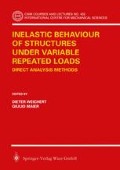Abstract
Shakedown theory for elastic-plastic-damage materials is exposed. Two kinds of shakedown are considered: i) Enlarged shakedown (or simply shakedown), in which both plastic deformations and damage eventually cease, after which the structural response is purely elastic; ii) Weak-form shakedown, in which plastic deformations eventually cease together with their consequences (including ductile damage), not necessarily damage from other sources (which are however escluded by assumption). An (enlarged) shakedown static-type theorem is given for a class of D-stable structures. Sufficient theorems of weak-form shakedown are provided, i.e. a static-type one (quite similar to that of Hachemi and Weichert (1992)), and a kinematic-type one, and possible applications of the latter theorems to ductile-damage structures are also indicated.
Access this chapter
Tax calculation will be finalised at checkout
Purchases are for personal use only
Preview
Unable to display preview. Download preview PDF.
References
Borino, G., Fuschi, P., and Polizzotto, C. (1996). Elastic-plastic-damage constitutive models with coupling internal variables. Mechanics Research Communications 23: 19–28.
Drucker, D. C. (1960). Plasticity. In Goodier, J. N., and Hoff, J. H., eds., Structural Mechanics. London: Pergamon Press. 407–455.
Druyanov, B., and Roman, I. (1995). Shakedown theorem extended to elastic nonperfectly plastic bodies. Mechanics Research Communications 22: 571–576.
Druyanov, B., and Roman, I. (1998). On adaptation (shakedown) of a class of damaged elastic bodies to cyclic loading. European Journal of Mechanics A/Solids 17: 71–78.
Feng, X. -Q., and Yu, S. -W. (1994). An upper bound on damage of elastic-plastic structures at shakedown. Int. Journal of Damage Mechanics 3: 277–289.
Feng, X. -Q., and Yu, S. -W. (1995). Damage and shakedown analysis of structures with strain-hardening. Int. Journal of Plasticity 11: 237–249.
Hachemi, A., and Weichert, D. (1992). An extension of the static shakedown theorem to a certain class of inelastic materials with damage. Archives of Mechanics 44: 491–498.
Hachemi, A., and Weichert, D. (1997). Application of shakedown theory to damaging inelastic material under mechanical and thermal loads. Int. J. of Mechanical Sciences 39: 1067–1076.
Hacherai, A., and Weichert, D. (1998). Numerical shakedown analysis of damaged structures. Computer Methods in Applied Mechanics and Engineering 160: 57–70.
Halphen, B. (1979). Accomodation et adaptation des structures elasto-visco-plastiques et plastiques. In Ecole Polytechnique Palaiseau, ed., Matériaux et Structures Sous Chargement Cyclique. Paris: Association Amicale des Ingénieurs Anciens Elèves, Ecôle National Ponts et Chaussees. 203–229.
Ju, J. W. (1989). On energy-based coupled elastoplastic damage theories: constitutive modeling and computational aspects. Int. Journal of Solids and Structures 25: 803–833.
Lemaitre, J., and Chaboche, J. -L. (1985). Mécanique des Materiaux Solides. Paris: Dunod.
Maier, G. (1987). A generalization to nonlinear hardening of the first shakedown theorem for discrete elastic-plastic models. Atti Accademia dei Lincei, Rendiconti Fisica 8, LXXXI: 161–174.
Perzyna, P. (1984). Constitutive modelling of dissipative solids for postcritical behaviour and failure. Journal of Engineering Materials and Technologies, ASME 106: 410–419.
Polizzotto, C., Borino, G., Caddemi, S., and Fuschi, P. (1991). Shakedown problems for material models with internal variables. European Journal of Mechanics A/Solids 10: 621–639.
Polizzotto, C., Borino, G., and Fuschi, P. (1996). An extended shakedown theory for elastic-plastic-damage material models. European Journal of Mechanics A/Solids 15: 825–858.
Polizzotto, C., Borino, G., and Fuschi, P. (2001). Weak forms of shakedown for elastic-plastic structures exhibiting ductile damage. Meccanica (to appear)
Siemaszko, A. (1993). Inadaptation analysis with hardening and damage. European Journal of Mechanics A/Solids 12: 237–248.
Author information
Authors and Affiliations
Editor information
Editors and Affiliations
Rights and permissions
Copyright information
© 2002 Springer-Verlag Wien
About this chapter
Cite this chapter
Polizzotto, C., Borino, G., Fuschi, P. (2002). Shakedown of Structures Accounting for Damage Effects. In: Weichert, D., Maier, G. (eds) Inelastic Behaviour of Structures under Variable Repeated Loads. International Centre for Mechanical Sciences, vol 432. Springer, Vienna. https://doi.org/10.1007/978-3-7091-2558-8_9
Download citation
DOI: https://doi.org/10.1007/978-3-7091-2558-8_9
Publisher Name: Springer, Vienna
Print ISBN: 978-3-211-83687-3
Online ISBN: 978-3-7091-2558-8
eBook Packages: Springer Book Archive

